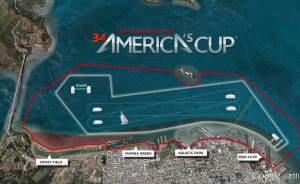Somewhere during our first leg of the trip, we had forgotten that this was a race. We had started joking that “we are cruisers now,” and as we would collectively make decisions, we would posit, “Are we thinking like racers or cruisers?”
The two groups are not mutually exclusive, nor are they in confrontation with one another. For example, there was a green-hulled boat only a few feet longer than ours who smoked by us, and it looked like a pretty comfy ride. Turns out that it was a custom-designed Farr 44 purpose-built to cruise comfortable AND go really, really fast while doing it. The point is that on the first leg of the trip, all of our little-racers-within were lulled into a sweet nap while we “enjoyed ourselves” in the cruising mode.

On the second leg–something snapped. Or popped. Or awoke. In all of us. Maybe it was the adrenaline from the start. Or, more likely, it was pulling into the Bahia de Tortugas with 60 boats from the fleet already waiting for us. I, for one, thought a we pulled into the last anchorage, “Wait a minute. We are down here on a RACE boat–with no insulation, exactly ZERO exquisite staterooms, with a two-burner stove and a one-holer toilet seat for which we fabricated a CURTAIN to give us the illusion of privacy, and weighing roughly less than the diesel, water and provisions
you are carrying on-board . . . and, YOU beat us?”
Regardless of what the motivation was, each of our little-racers-within awoke from their nap, and they were hungry. No motor. Spinnaker through the night. No set the spinnaker to a conservative setting and forget it. This was war–or, better, this was a RACE! There isn’t really a trophy, per se, but we wanted an illusionary one. We wanted “bragging rights” which has its own HUGE currency in the superstitious, over-indulgent, beer-swilling, story-telling world of sailors. And, race we did.
The winds picked up and were blowing around 25 knots during the end of the first day, and Nathan hand-drove for hours–keeping the boat on the edge to drain every ounce of speed out of her . . . because Marishanna shines in these conditions: downwind, big seas, and 25 knots of breeze. If it wasn’t for the warmer water, she might have thought she was at home in San Francisco.
With the spinnaker up and sailing downwind, a racing sailboat can do magical things. If the driver knows what he/she is doing, they feel the wave approaching (there is also a rhythm to it), and they turn the transom of the boat to sit firmly on the wave, and for a few brief moments, the hull partially pulls out of the water and basically “surfs” down the waves. By definition, sailboats should only be able to go a certain speed calculated by the
length of the hull. In these brief moments, however, a light, fast, raceboat with a large spinnaker sail up, properly-designed stern, a powerful wave, and a good driver, and you can reach speeds above your hull-speed (Marishanna’s hull-speed is in the mid-to-high 7 knots).
With Nathan driving and the conditions right, we peeled off consistent 10’s–for awhile, doing it with almost every wave. We hit some pretty regular 11’s and saw numbers as high as 15 knots. And, that is how you win races.
Sailing to Bahia Santa Maria was about 280 nautical miles. We ripped off the first 180 miles in about 20 hours, and as the wind died from 25 knots to 15 knots and down to 10knots, we continued to drain every ounce of speed we could get from the boat.
Somewhere in the early hours of the morning (around 4am), a bit more than 2 days after we started, we crossed the finish line. We weren’t the first to arrive, but at least we were respectable (in the top 20) and, had our pick of the anchorages.
And, yes, the green boat was already there . . . .






